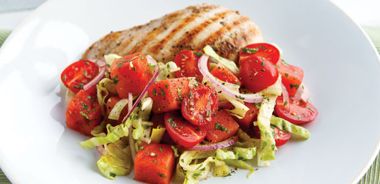Melon Meets Its Match

This side salad only needs a light dressing to let the sweet melon and earthy herbs shine through. It also makes an excellent accompaniment to grilled chicken or fish.
Dressing
1/4 cup (60 mL) cider or tarragon vinegar
1 Tbsp (15 mL) maple syrup or honey
1/4 tsp (1 mL) sea salt
1/4 tsp (1 mL) cayenne pepper
3 Tbsp (45 mL) extra-virgin olive oil
Salad
2 cups (500 mL) diced watermelon
16 cherry tomatoes, cut in half (or quarters, if large)
3 Tbsp (45 mL) each of coarsely chopped cilantro, mint, and parsley
1 cup (250 mL) julienned iceberg lettuce
1/4 red onion, thinly sliced
To make dressing, whisk vinegar with syrup or honey, salt, and cayenne. Whisk in oil until emulsified. Recipe makes a generous 1/4 cup (60 mL) dressing.
Place all salad ingredients together in bowl. Drizzle with dressing, then toss to mix. Let stand 5 minutes to let flavours blend, then arrange on platter or in shallow bowl.
Serves 6 as a side dish.
Each serving contains: 101 calories; 1 g protein; 7 total fat (1 g sat. fat, 0 g trans fat); 10 g carbohydrates; 1 g fibre; 105 mg sodium
source: "Fresh Summer Salads", alive #357, July 2012




